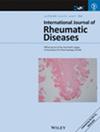Neutrophil Z Is a Novel Marker to Differentiate Disease Flares From Bacterial Infections in Febrile SLE Patients
Abstract
Aim and Objectives
To assess the role of newer biomarkers like neutrophil Z, myeloid-related protein 8/14 (MRP 8/14), IL-6, sCD14, and neutrophil CD64 (nCD64) to distinguish flare from infection in febrile lupus patients.
Methods
In this prospective multicentric observational study to determine the etiology of fever in febrile lupus patients, in addition to routine tests, serum procalcitonin, neutrophil X, neutrophil Y, and neutrophil Z were done. sCD14, MRP8/14, and IL-6 were done by ELISA. nCD64 expression was measured by flow cytometry. All these biomarkers were assessed individually and in combination to see their ability to distinguish between infection and lupus flare.
Results
Among 159 febrile SLE patients, there were 55 infections, 65 disease flares, 38 flares and infections combined, and 1 malignancy. Patients with bacterial infections had a higher CRP, procalcitonin, neutrophil-to-lymphocyte ratio, Neutrophil Z, sCD14 levels, and neutrophil CD64 expression. While patients with flares had lower C3, C4, and higher anti-DsDNA antibody levels. IL-6 and MRP8/14 levels were similar in both groups. Combination of neut-Z with C3 or anti-dsDNA antibody could discriminate between flare and infection with AUC 0.88 (0.80–0.96) and 0.86 (0.78–0.95). Addition of TLC or procalcitonin or nCD64 MFI to these scores improved them marginally. Though composite scores with CRP and anti-dsDNA/procalcitonin also performed well but these were inferior to neutrophil Z-based composite models. These results were consistent in sensitivity analysis.
Conclusion
Neutrophil Z, complement C3, anti-dsDNA antibody levels, and TLC or procalcitonin-based composite score are good tools to differentiate between infection and flare in a febrile lupus patient. Serum MRP 8/14, IL-6, sCD14, and nCD64 did not perform well. Simple biomarkers such as neut-Z should be investigated further in SLE.

 求助内容:
求助内容: 应助结果提醒方式:
应助结果提醒方式:


